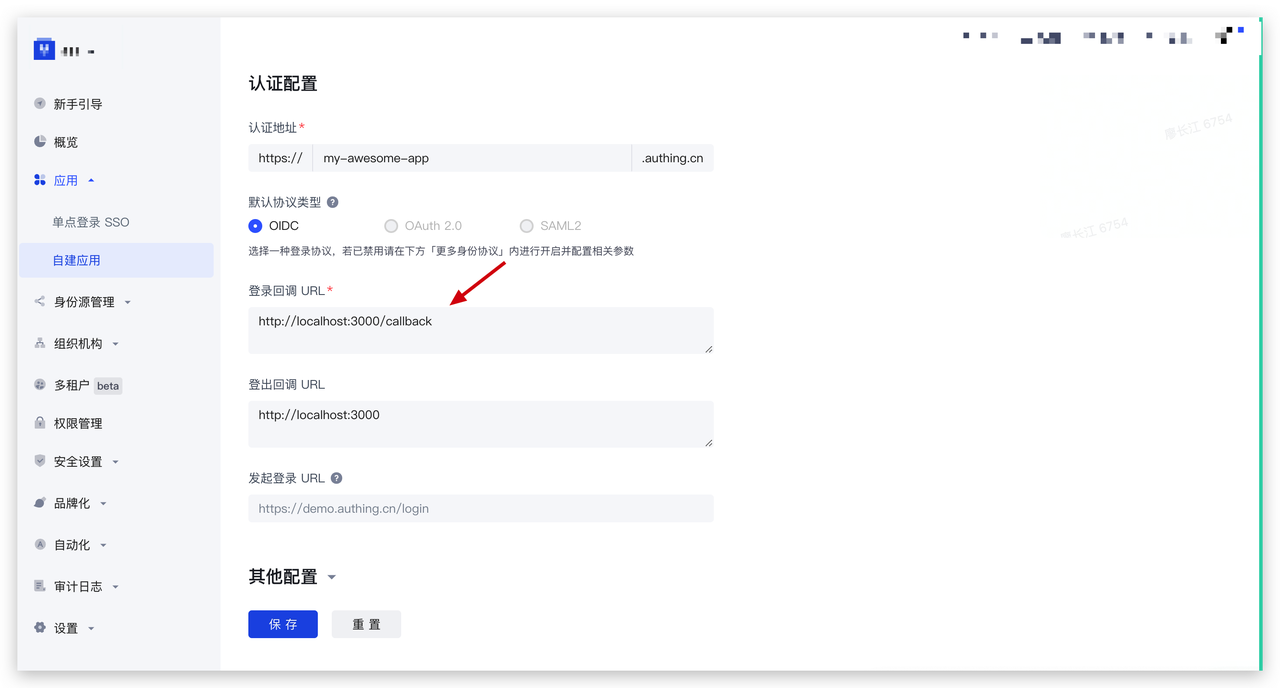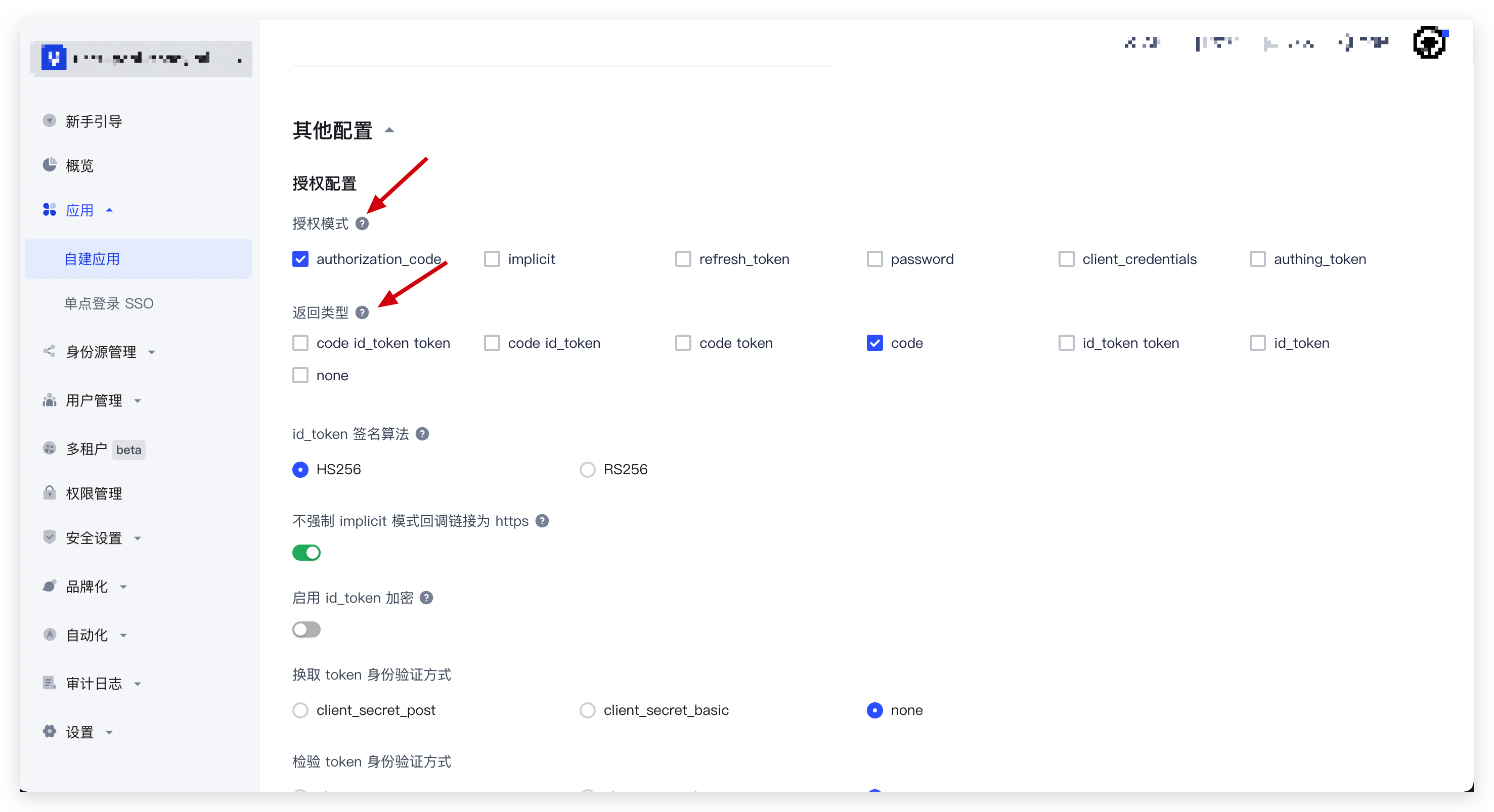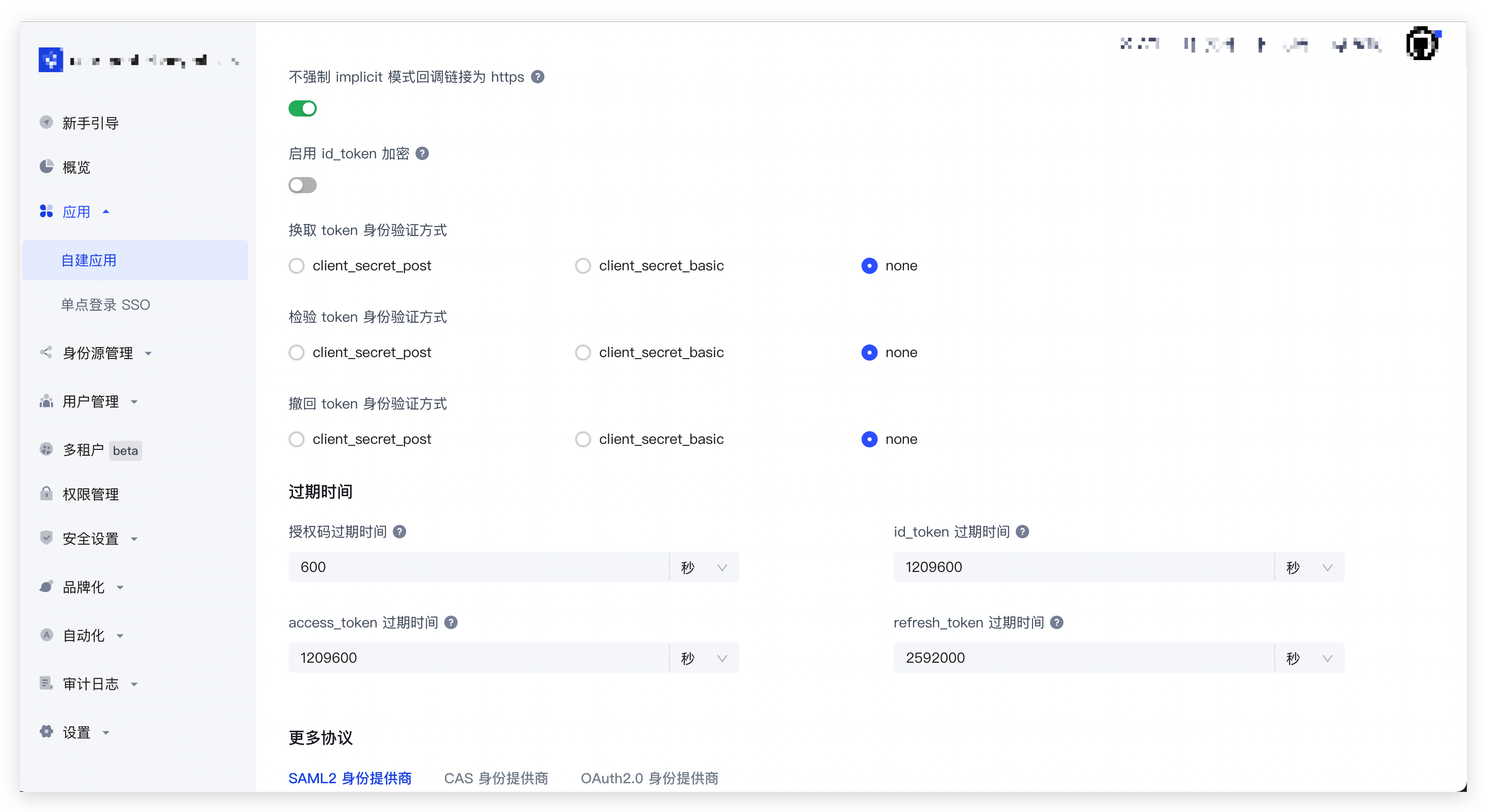¶ 了解 Guard 模式
¶ 托管模式 & 内嵌模式
托管模式: 指跳转到 Authing 提供的托管登录页。Authing 默认使用 OIDC 标准协议认证,你的用户在登录时将始终由 Authing 提供的认证最佳实践保驾护航。
- 安全性:你的业务系统将用户重定向到 Authing,用户在此进行身份验证,然后重定向回在控制台配置的应用回调连接。
- 样式丰富性:托管模式提供了登录注册表单自定义配置,可通过控制台配置和 CSS 进行界面自定义。
- 集成便利性:你不需要额外运维登录页面,Authing 将负责此页面的维护和升级,当 Authing 有新功能发布之后,你不需要做任何操作即可获取最新能力。
内嵌模式: 指的是将 Authing 提供的登录组件(Guard)嵌入到你的 Web 应用中。仅需要几行 JavaScript 代码即可,该模式包含两种形态:
- 普通形态:样式与托管模式一致,但灵活之处在于你可以将它嵌入到你的任意的 DOM 节点。
- 模态框形态:和普通形态类似,只不过通过模态框(Modal)的样式进行展示。
对于大多数登录认证场景,我们推荐使用「托管模式」进行集成。这是最简便、安全、通用的 Authing 认证最佳实践。
¶ 使用托管模式
托管模式将跳转到 Authing 提供的托管登录页。由于此模式 Authing 默认使用 OIDC 标准协议认证,你需要进行以下额外配置:
- 在 Authing 控制台 (opens new window) 的 应用 -> 自建应用 -> 应用详情 中配置 登录回调 URL,回调地址为下述示例代码中 Callback 页面地址,此处以
http://localhost:3000/callback为例:

- 在应用详情的 协议配置 -> 授权配置 中,授权模式 选择 authentication_code,返回类型 选择 code:

- 如果是标准 Web 应用,请在应用详情的 协议配置 -> 授权配置 中,请确保应用的 换取 token 身份验证方式 设置为了 none。
如果你的应用类型为单页 Web 应用,此次选项会被隐藏,为正常情况。

¶ Guard 托管模式代码示例
// Jump.tsx
// React16 / 17
// 代码示例:https://github.com/Authing/Guard/tree/v5/examples/guard-react/normal/src/pages/Jump.tsx
import { useGuard } from "@authing/guard-react";
// React 18
// 代码示例:https://github.com/Authing/Guard/tree/v5/examples/guard-react18/normal/src/pages/Jump.tsx
// import { useGuard } from '@authing/guard-react18';
export default function Jump() {
const guard = useGuard();
// 跳转到 Authing 托管页面登录
const startWithRedirect = () => guard.startWithRedirect();
return (
<div>
<div>
<button className="authing-button" onClick={startWithRedirect}>
Start With Redirect
</button>
</div>
</div>
);
}
// Callback.tsx
// React 16 / 17
// 代码示例:https://github.com/Authing/Guard/tree/v5/examples/guard-react/normal/src/pages/Callback.tsx
import { JwtTokenStatus, useGuard, User } from '@authing/guard-react';
// React 18
// 代码示例:https://github.com/Authing/Guard/tree/v5/examples/guard-react18/normal/src/pages/Callback.tsx
// import { JwtTokenStatus, useGuard, User } from '@authing/guard-react18';
import React, { useEffect } from 'react';
import { useHistory } from 'react-router-dom';
export default function Callback() {
const history = useHistory()
const guard = useGuard()
const handleCallback = async () => {
try {
// 1. 触发 guard.handleRedirectCallback() 方法完成登录认证
// 用户认证成功之后,我们会将用户的身份凭证存到浏览器的本地缓存中
await guard.handleRedirectCallback()
// 2. 处理完 handleRedirectCallback 之后,你需要先检查用户登录态是否正常
const loginStatus: JwtTokenStatus | undefined = await guard.checkLoginStatus()
if (!loginStatus) {
return console.error('Guard is not get login status')
}
// 3. 获取到登录用户的用户信息
const userInfo: User | null = await guard.trackSession()
console.log(userInfo)
// 你也可以重定向到你的任意业务页面,比如重定向到用户的个人中心
// 如果你希望实现登录后跳转到同一页面的效果,可以通过在调用 startWithRedirect 时传入的自定义 state 实现
// 之后你在这些页面可以通过 trackSession 方法获取用户登录态和用户信息
// 示例一:跳转到固定页面
history.replace('/personal')
// 示例二:获取自定义 state,进行特定操作
// const search = window.location.search
// 从 URL search 中解析 state
} catch (e) {
// 登录失败,推荐再次跳转到登录页面
console.error('Guard handleAuthingLoginCallback error: ', e)
}
}
useEffect(() => {
handleCallback()
})
return <div>This is Callback page</div>
}
// Personal.tsx
// React 16 / 17
// 代码示例:https://github.com/Authing/Guard/tree/v5/examples/guard-react/normal/src/pages/Personal.tsx
import { useGuard, User } from '@authing/guard-react';
// React 18
// 代码示例:https://github.com/Authing/Guard/tree/v5/examples/guard-react18/normal/src/pages/Personal.tsx
// import { useGuard, User } from '@authing/guard-react18';
import React, { useEffect, useState } from 'react';
export default function Personal() {
const [userInfo, setUserInfo] = useState('')
const guard = useGuard()
useEffect(() => {
guard.trackSession().then((res: User | null) => {
setUserInfo(JSON.stringify(res, null, 2))
})
}, [])
return (
<div>
{userInfo && (
<div>
<div>用户信息:</div>
<textarea cols={100} rows={30} defaultValue={userInfo}></textarea>
</div>
)}
</div>
)
}
// 代码示例:https://github.com/Authing/Guard/tree/v5/examples/guard-vue2/normal/src/views/Jump.vue
// Jump.vue
export default {
methods: {
startWithRedirect() {
// 跳转到 Authing 托管页面登录
this.$guard.startWithRedirect();
},
},
};
// 代码示例:https://github.com/Authing/Guard/tree/v5/examples/guard-vue2/normal/src/views/Callback.vue
// Callback.vue
export default {
data () {
return {
message: 'This is callback page ~'
}
},
mounted () {
this.handleAuthingLoginCallback()
},
methods: {
async handleAuthingLoginCallback () {
try {
// 1. 触发 guard.handleRedirectCallback() 方法完成登录认证
// 用户认证成功之后,我们会将用户的身份凭证存到浏览器的本地缓存中
await this.$guard.handleRedirectCallback()
// 2. 处理完 handleRedirectCallback 之后,你需要先检查用户登录态是否正常
const loginStatus = await this.$guard.checkLoginStatus()
if (!loginStatus) {
return console.error('Guard is not get login status')
}
// 3. 获取到登录用户的用户信息
const userInfo = await this.$guard.trackSession()
console.log(userInfo)
// 你也可以重定向到你的任意业务页面,比如重定向到用户的个人中心
// 如果你希望实现登录后跳转到同一页面的效果,可以通过在调用 startWithRedirect 时传入的自定义 state 实现
// 之后你在这些页面可以通过 trackSession 方法获取用户登录态和用户信息
// 示例一:跳转到固定页面
this.$router.replace('/personal')
// 示例二:获取自定义 state,进行特定操作
// const search = window.location.search
// 从 URL search 中解析 state
} catch (e) {
// 登录失败,推荐再次跳转到登录页面
console.error('Guard handleAuthingLoginCallback error: ', e)
}
}
}
}
<template>
<div class="personal-container">
<!-- 代码示例:https://github.com/Authing/Guard/tree/v5/examples/guard-vue2/normal/src/views/Personal.vue -->
<!-- Personal.vue -->
<textarea id="" cols="100" rows="30" :value="userInfo"></textarea>
</div>
</template>
<script>
export default {
data () {
return {
userInfo: ''
}
},
created () {
this.getUserInfo()
},
methods: {
async getUserInfo () {
const userInfo = await this.$guard.trackSession()
this.userInfo = JSON.stringify(userInfo, null, 2)
}
}
}
</script>
// 代码示例:https://github.com/Authing/Guard/tree/v5/examples/guard-vue3/normal/src/views/Jump.vue
// Jump.vue
import { useGuard } from "@authing/guard-vue3";
const guard = useGuard();
const startWithRedirect = () => {
// 跳转到 Authing 托管页面登录
guard.startWithRedirect();
};
<template>
<div class="personal-container">
<!-- 代码示例:https://github.com/Authing/Guard/tree/v5/examples/guard-vue3/normal/src/views/Callback.vue -->
<!-- Callback.vue -->
<textarea id="" cols="100" rows="30" :value="userInfo"></textarea>
</div>
</template>
<script lang="ts" setup>
import { onMounted } from 'vue'
import { useRouter } from 'vue-router'
import { useGuard } from '@authing/guard-vue3'
import type { JwtTokenStatus, User } from '@authing/guard-vue3'
const router = useRouter()
const guard = useGuard()
const handleAuthingLoginCallback = async () => {
try {
// 1. 触发 guard.handleRedirectCallback() 方法完成登录认证
// 用户认证成功之后,我们会将用户的身份凭证存到浏览器的本地缓存中
await guard.handleRedirectCallback()
// 2. 处理完 handleRedirectCallback 之后,你需要先检查用户登录态是否正常
const loginStatus: JwtTokenStatus | undefined = await guard.checkLoginStatus()
if (!loginStatus) {
return console.error('Guard is not get login status')
}
// 3. 获取到登录用户的用户信息
const userInfo: User | null = await guard.trackSession()
console.log(userInfo)
// 你也可以重定向到你的任意业务页面,比如重定向到用户的个人中心
// 如果你希望实现登录后跳转到同一页面的效果,可以通过在调用 startWithRedirect 时传入的自定义 state 实现
// 之后你在这些页面可以通过 trackSession 方法获取用户登录态和用户信息
// 示例一:跳转到固定页面
router.replace({
name: 'Personal'
})
// 示例二:获取自定义 state,进行特定操作
// const search = window.location.search
// 从 URL search 中解析 state
} catch (e) {
// 登录失败,推荐再次跳转到登录页面
console.error('Guard handleAuthingLoginCallback error: ', e)
}
}
onMounted(() => {
handleAuthingLoginCallback()
})
</script>
<template>
<div class="personal-container">
<!-- 代码示例:https://github.com/Authing/Guard/tree/v5/examples/guard-vue3/normal/src/views/Personal.vue -->
<!-- Personal.vue -->
<textarea id="" cols="100" rows="30" :value="userInfo"></textarea>
</div>
</template>
<script lang="ts" setup>
import { ref, onMounted } from 'vue'
import { useGuard } from '@authing/guard-vue3'
import type { User } from '@authing/guard-vue3'
const userInfo = ref<string>('')
const guard = useGuard()
const getUserInfo = async () => {
const _userInfo: User | null = await guard.trackSession()
userInfo.value = JSON.stringify(_userInfo, null, 2)
}
onMounted(() => {
getUserInfo()
})
</script>
// 代码示例:https://github.com/Authing/Guard/tree/v5/examples/guard-angular/normal/src/app/pages/jump/jump.component.ts
// jump.component.ts
// Angular 组件中使用 Guard API
import { Component } from "@angular/core";
import { GuardService } from "@authing/guard-angular";
@Component({
selector: "jump-container",
templateUrl: "./jump.component.html",
styleUrls: ["./jump.component.css"],
})
export class HomeComponent {
constructor(
// 使用 Angular 依赖注入,获取 Guard 实例
private guard: GuardService
) {}
startWithRedirect() {
// 跳转到 Authing 托管页面登录
this.guard.client.startWithRedirect();
}
}
// 代码示例:https://github.com/Authing/Guard/tree/v5/examples/guard-angular/normal/src/app/pages/callback/callback.component.ts
// callback.component.ts
import { Component } from '@angular/core'
import { Router } from '@angular/router'
import { GuardService, JwtTokenStatus, User } from '@authing/guard-angular'
@Component({
selector: 'callback-container',
templateUrl: './callback.component.html',
styleUrls: ['./callback.component.css']
})
export class CallbackComponent {
constructor (
private router: Router,
private guard: GuardService
) {}
ngOnInit () {
this.handleAuthingLoginCallback()
}
async handleAuthingLoginCallback () {
try {
// 1. 触发 guard.handleRedirectCallback() 方法完成登录认证
// 用户认证成功之后,我们会将用户的身份凭证存到浏览器的本地缓存中
await this.guard.client.handleRedirectCallback()
// 2. 处理完 handleRedirectCallback 之后,你需要先检查用户登录态是否正常
const loginStatus: JwtTokenStatus | undefined = await this.guard.client.checkLoginStatus()
if (!loginStatus) {
return console.error('Guard is not get login status')
}
// 3. 获取到登录用户的用户信息
const userInfo: User | null = await this.guard.client.trackSession()
console.log(userInfo)
// 你也可以重定向到你的任意业务页面,比如重定向到用户的个人中心
// 如果你希望实现登录后跳转到同一页面的效果,可以通过在调用 startWithRedirect 时传入的自定义 state 实现
// 之后你在这些页面可以通过 trackSession 方法获取用户登录态和用户信息
// 示例一:跳转到固定页面
this.router.navigateByUrl('personal', {
replaceUrl: true
})
// 示例二:获取自定义 state,进行特定操作
// const search = window.location.search
// 从 URL search 中解析 state
} catch (e) {
// 登录失败,推荐再次跳转到登录页面
console.error('Guard handleAuthingLoginCallback error: ', e)
}
}
}
// 代码示例:https://github.com/Authing/Guard/tree/v5/examples/guard-angular/normal/src/app/pages/personal/personal.component.ts
// personal.component.ts
import { Component } from '@angular/core'
import { GuardService, User } from '@authing/guard-angular'
@Component({
selector: 'personal-container',
templateUrl: './personal.component.html',
styleUrls: ['./personal.component.css']
})
export class PersonalComponent {
constructor(private guard: GuardService) {}
userInfo = ''
ngOnInit() {
this.getUserInfo()
}
async getUserInfo() {
const _userInfo: User | null = await this.guard.client.trackSession()
this.userInfo = JSON.stringify(_userInfo || '', null, 2)
}
}
// 代码示例:https://github.com/Authing/Guard/tree/v5/examples/guard/normal/jump.html
// jump.html
const guard = new GuardFactory.Guard({
// 你可以前往 Authing 控制台的本应用详情页查看你的 App ID
appId: "AUTHING_APP_ID",
// 如果你使用的是私有化部署的 Authing 服务,需要传入自定义 host,如:
// host: 'https://my-authing-app.example.com',
// 默认情况下,会使用你在 Authing 控制台中配置的第一个回调地址为此次认证使用的回调地址。
// 如果你配置了多个回调地址,也可以手动指定(此地址也需要加入到应用的「登录回调 URL」中):
// redirectUri: "YOUR_REDIRECT_URI"
});
function startWithRedirect() {
// 跳转到 Authing 托管页面登录
guard.startWithRedirect();
}
// 代码示例:https://github.com/Authing/Guard/tree/v5/examples/guard/normal/callback.html
// callback.html
const guard = new GuardFactory.Guard(guardOptions)
handleAuthingLoginCallback()
async function handleAuthingLoginCallback () {
try {
// 1. 触发 guard.handleRedirectCallback() 方法完成登录认证
// 用户认证成功之后,我们会将用户的身份凭证存到浏览器的本地缓存中
await guard.handleRedirectCallback()
// 2. 处理完 handleRedirectCallback 之后,你需要先检查用户登录态是否正常
const loginStatus = await guard.checkLoginStatus()
if (!loginStatus) {
return console.error('Guard is not get login status')
}
// 3. 获取到登录用户的用户信息
const userInfo = await guard.trackSession()
console.log(userInfo)
// 你也可以重定向到你的任意业务页面,比如重定向到用户的个人中心
// 如果你希望实现登录后跳转到同一页面的效果,可以通过在调用 startWithRedirect 时传入的自定义 state 实现
// 之后你在这些页面可以通过 trackSession 方法获取用户登录态和用户信息
// 示例一:跳转到固定页面
window.location.replace(personalPageUrl)
// 示例二:获取自定义 state,进行特定操作
// const search = window.location.search
// 从 URL search 中解析 state
} catch (e) {
// 登录失败,推荐再次跳转到登录页面
console.error('Guard handleAuthingLoginCallback error: ', e)
}
}
<!DOCTYPE html>
<html lang="en">
<head>
<meta charset="UTF-8">
<meta http-equiv="X-UA-Compatible" content="IE=edge">
<meta name="viewport" content="width=device-width, initial-scale=1.0">
<title>Authing Guard Demo - Personal</title>
<script src="https://cdn.authing.co/packages/guard/latest/guard.min.js"></script>
<script src="https://cdn.authing.co/packages/face-api/face-api.min.js"></script>
<script src="./config.js"></script>
<link rel="stylesheet" href="https://cdn.authing.co/packages/guard/latest/guard.min.css" />
</head>
<body>
<!-- 代码示例:https://github.com/Authing/Guard/tree/v5/examples/guard/normal/personal.html -->
<!-- personal.html -->
<button onclick="getUserInfo()">Get User Info</button>
<script>
const guard = new GuardFactory.Guard(guardOptions)
async function getUserInfo () {
const userInfo = await guard.trackSession()
console.log(userInfo)
}
</script>
</body>
</html>
¶ 使用内嵌模式
¶ 普通形态
// React 16 / 17
// 代码示例:https://github.com/Authing/Guard/tree/v5/examples/guard-react/normal/src/pages/Embed.tsx
import { useGuard, User } from "@authing/guard-react";
// React 18
// 代码示例:https://github.com/Authing/Guard/tree/v5/examples/guard-react18/normal/src/pages/Embed.tsx
// import { useGuard, User } from "@authing/guard-react18";
import React, { useEffect } from "react";
export default function Login() {
// 获取 Guard 实例
const guard = useGuard();
useEffect(() => {
// 使用 start 方法挂载 Guard 组件到你指定的 DOM 节点,登录成功后返回 userInfo
guard.start("#authing-guard-container").then((userInfo: User) => {
console.log("userInfo: ", userInfo);
});
}, []);
return (
<div>
<div id="authing-guard-container"></div>
</div>
);
}
<template>
<!-- 代码示例:https://github.com/Authing/Guard/tree/v5/examples/guard-vue2/normal/src/views/Embed.vue -->
<div id="authing-guard-container"></div>
</template>
<script>
export default {
mounted() {
// 使用 start 方法挂载 Guard 组件到你指定的 DOM 节点,登录成功后返回 userInfo
this.$guard.start("#authing-guard-container").then((userInfo) => {
console.log("userInfo: ", userInfo);
});
},
};
</script>
<template>
<!-- 代码示例:https://github.com/Authing/Guard/tree/v5/examples/guard-vue3/normal/src/views/Embed.vue -->
<div id="authing-guard-container"></div>
</template>
<script lang="ts" setup>
import { onMounted } from "vue";
import { useGuard } from "@authing/guard-vue3";
import type { User } from "@authing/guard-vue3";
const guard = useGuard();
onMounted(() => {
// 使用 start 方法挂载 Guard 组件到你指定的 DOM 节点,登录成功后返回 userInfo
guard.start("#authing-guard-container").then((userInfo: User) => {
console.log("userInfo: ", userInfo);
});
});
</script>
// 代码示例:https://github.com/Authing/Guard/tree/v5/examples/guard-angular/normal/src/app/pages/embed/embed.component.ts
import { Component } from "@angular/core";
import { GuardService, User } from "@authing/guard-angular";
@Component({
selector: "embed-container",
templateUrl: "./embed.component.html",
styleUrls: ["./embed.component.css"]
})
export class LoginComponent {
constructor(private guard: GuardService) {}
ngOnInit() {
// 使用 start 方法挂载 Guard 组件到你指定的 DOM 节点,登录成功后返回 userInfo
this.guard.client
.start("#authing-guard-container")
.then((userInfo: User) => {
console.log("userInfo: ", userInfo);
});
}
}
<!-- https://github.com/Authing/Guard/tree/v5/examples/guard/normal/embed.html -->
<div id="authing-guard-container"></div>
// 获取 Guard 实例
const guard = new GuardFactory.Guard({
// 你可以前往 Authing 控制台的本应用详情页查看你的 App ID
appId: "AUTHING_APP_ID",
// 如果你使用的是私有化部署的 Authing 服务,需要传入自定义 host,如:
// host: 'https://my-authing-app.example.com',
// 默认情况下,会使用你在 Authing 控制台中配置的第一个回调地址为此次认证使用的回调地址。
// 如果你配置了多个回调地址,也可以手动指定(此地址也需要加入到应用的「登录回调 URL」中):
// redirectUri: "YOUR_REDIRECT_URI"
});
// 使用 start 方法挂载 Guard 组件到你指定的 DOM 节点,登录成功后返回 userInfo
guard.start("#authing-guard-container").then((userInfo) => {
console.log("userInfo: ", userInfo);
});
¶ 模态框形态
初始化时,你需要将初始化参数的 mode 设置成 modal。
你可以通过 guard 实例 start 方法对『模态框』进行渲染,同时可以通过 show 和 hide 控制『模态框』的显示和隐藏:
// App.tsx
// React 16 / 17
// 代码示例:https://github.com/Authing/Guard/tree/v5/examples/guard-react/modal/src/App.tsx
import { GuardProvider } from "@authing/guard-react";
import "@authing/guard-react/dist/esm/guard.min.css";
// React 18
// 代码示例:https://github.com/Authing/Guard/tree/v5/examples/guard-react18/modal/src/App.tsx
// import { GuardProvider } from "@authing/guard-react18";
// import "@authing/guard-react18/dist/esm/guard.min.css";
import React from "react";
import RouterComponent from "./router";
function App() {
return (
<GuardProvider
appId="AUTHING_APP_ID"
mode="modal"
// 如果你使用的是私有化部署的 Authing 服务,需要传入自定义 host,如:
// host="https://my-authing-app.example.com"
// 默认情况下,会使用你在 Authing 控制台中配置的第一个回调地址为此次认证使用的回调地址。
// 如果你配置了多个回调地址,也可以手动指定(此地址也需要加入到应用的「登录回调 URL」中):
// redirectUri="YOUR_REDIRECT_URI"
>
<RouterComponent></RouterComponent>
</GuardProvider>
);
}
// Embed.tsx
// React 16 / 17
// 代码示例:https://github.com/Authing/Guard/tree/v5/examples/guard-react/modal/src/pages/Embed.tsx
import { useGuard, User } from "@authing/guard-react";
// React 18
// 代码示例:https://github.com/Authing/Guard/tree/v5/examples/guard-react18/modal/src/pages/Embed.tsx
// import { useGuard, User } from "@authing/guard-react18";
export default function Embed() {
const guard = useGuard();
const showGuard = () => guard.show();
useEffect(() => {
// 挂载模态框,当用户完成登录之后,你可以获取到用户信息
guard.start("#authing-guard-container").then((userInfo: User) => {
console.log("userInfo: ", userInfo);
setTimeout(() => {
guard.hide();
}, 2000);
});
}, []);
return (
<div>
<button className="authing-button" onClick={showGuard}>
Show Guard
</button>
<div>
模态窗口打开并登录成功后会在 2 秒内调用 hide 方法关闭模态窗口,用于展示 hide 方法的效果
</div>
<div>模态框自动关闭后,可以点击 Show Guard 按钮再次显示</div>
<div id="authing-guard-container"></div>
</div>
);
}
// 代码示例:https://github.com/Authing/Guard/tree/v5/examples/guard-vue2/modal/src/main.js
// main.js
import Vue from "vue";
import { GuardPlugin } from "@authing/guard-vue2";
import "@authing/guard-vue2/dist/esm/guard.min.css";
Vue.use(GuardPlugin, {
appId: "AUTHING_APP_ID",
mode: "modal",
// 如果你使用的是私有化部署的 Authing 服务,需要传入自定义 host,如:
// host: 'https://my-authing-app.example.com',
// 默认情况下,会使用你在 Authing 控制台中配置的第一个回调地址为此次认证使用的回调地址。
// 如果你配置了多个回调地址,也可以手动指定(此地址也需要加入到应用的「登录回调 URL」中):
// redirectUri: "YOUR_REDIRECT_URI"
});
<template>
<!-- 代码示例:https://github.com/Authing/Guard/tree/v5/examples/guard-vue2/modal/src/views/Embed.vue -->
<!-- Embed.vue -->
<div class="embed-container">
<button class="authing-button" @click="showGuard">Show Guard</button>
<div>
模态窗口打开并登录成功后会在 2 秒内调用 hide 方法关闭模态窗口,用于展示 hide 方法的效果
</div>
<div>模态框自动关闭后,可以点击 Show Guard 按钮再次显示</div>
<div id="authing-guard-container"></div>
</div>
</template>
<script>
export default {
mounted() {
// 使用 start 方法挂载 Guard 组件到你指定的 DOM 节点,登录成功后返回 userInfo
this.$guard.start("#authing-guard-container").then((userInfo) => {
console.log("userInfo: ", userInfo);
setTimeout(() => {
this.$guard.hide();
}, 2000);
});
},
methods: {
showGuard() {
this.$guard.show();
},
},
};
</script>
// 代码示例:https://github.com/Authing/Guard/tree/v5/examples/guard-vue3/modal/src/main.ts
// main.ts
import { createApp } from "vue";
import App from "./App.vue";
import { createGuard } from "@authing/guard-vue3";
import "@authing/guard-vue3/dist/esm/guard.min.css";
const app = createApp(App);
app.use(
createGuard({
appId: "AUTHING_APP_ID",
mode: "modal",
// 如果你使用的是私有化部署的 Authing 服务,需要传入自定义 host,如:
// host: 'https://my-authing-app.example.com',
// 默认情况下,会使用你在 Authing 控制台中配置的第一个回调地址为此次认证使用的回调地址。
// 如果你配置了多个回调地址,也可以手动指定(此地址也需要加入到应用的「登录回调 URL」中):
// redirectUri: "YOUR_REDIRECT_URI"
})
);
<template>
<!-- 代码示例:https://github.com/Authing/Guard/tree/v5/examples/guard-vue3/modal/src/views/Embed.vue -->
<!-- Embed.vue -->
<div class="embed-container">
<button class="authing-button" @click="showGuard">Show Guard</button>
<div>
模态窗口打开并登录成功后会在 2 秒内调用 hide 方法关闭模态窗口,用于展示 hide 方法的效果
</div>
<div>模态框自动关闭后,可以点击 Show Guard 按钮再次显示</div>
<div id="authing-guard-container"></div>
</div>
</template>
<script lang="ts" setup>
import { onMounted } from "vue";
import { useGuard } from "@authing/guard-vue3";
const guard = useGuard();
const showGuard = () => guard.show();
onMounted(() => {
// 使用 start 方法挂载 Guard 组件到你指定的 DOM 节点,登录成功后返回 userInfo
guard.start("#authing-guard-container").then((userInfo) => {
console.log("userInfo: ", userInfo);
setTimeout(() => {
guard.hide();
}, 2000);
});
});
</script>
// 代码示例:https://github.com/Authing/Guard/tree/v5/examples/guard-angular/modal/src/app/app.module.ts
// app.module.ts
import { NgModule } from "@angular/core";
import { BrowserModule } from "@angular/platform-browser";
import { AppRoutingModule } from "./app-routing.module";
import { AppComponent } from "./app.component";
import { GuardModule } from "@authing/guard-angular";
@NgModule({
declarations: [AppComponent],
imports: [
BrowserModule,
AppRoutingModule,
GuardModule.forRoot({
appId: "AUTHING_APP_ID",
mode: "modal",
// 如果你使用的是私有化部署的 Authing 服务,需要传入自定义 host,如:
// host: 'https://my-authing-app.example.com',
// 默认情况下,会使用你在 Authing 控制台中配置的第一个回调地址为此次认证使用的回调地址。
// 如果你配置了多个回调地址,也可以手动指定(此地址也需要加入到应用的「登录回调 URL」中):
// redirectUri: "YOUR_REDIRECT_URI"
}),
],
providers: [],
bootstrap: [AppComponent],
})
export class AppModule {}
// 代码示例:https://github.com/Authing/Guard/tree/v5/examples/guard-angular/modal/src/app/pages/embed/embed.component.ts
// embed.component.ts
import { Component } from "@angular/core";
import { GuardService, User } from "@authing/guard-angular";
@Component({
selector: "embed-container",
templateUrl: "./embed.component.html",
styleUrls: ["./embed.component.css"],
})
export class EmbedComponent {
constructor(private guard: GuardService) {}
ngOnInit() {
this.guard.client
.start("#authing-guard-container")
.then((userInfo: User) => {
console.log("userInfo: ", userInfo);
setTimeout(() => {
this.guard.client.hide();
}, 2000);
});
}
showGuard() {
this.guard.client.show();
}
}
<!-- 代码示例:https://github.com/Authing/Guard/tree/v5/examples/guard/modal/embed.html -->
<button onclick="showGuard()">Show Guard</button>
<div>
模态窗口打开并登录成功后会在 2 秒内调用 hide 方法关闭模态窗口,用于展示 hide
方法的效果
</div>
<div>模态框自动关闭后,可以点击 Show Guard 按钮再次显示</div>
<div id="authing-guard-container"></div>
const guard = new GuardFactory.Guard({
appId: "AUTHING_APP_ID",
mode: "modal",
// 如果你使用的是私有化部署的 Authing 服务,需要传入自定义 host,如:
// host: 'https://my-authing-app.example.com',
// 默认情况下,会使用你在 Authing 控制台中配置的第一个回调地址为此次认证使用的回调地址。
// 如果你配置了多个回调地址,也可以手动指定(此地址也需要加入到应用的「登录回调 URL」中):
// redirectUri: "YOUR_REDIRECT_URI"
});
guard.start("#authing-guard-container").then((userInfo) => {
// 登录成功后将在 then 回调中获取到 userInfo
console.log("userInfo: ", userInfo);
setTimeout(() => {
guard.hide();
}, 2000);
});
function showGuard() {
guard.show();
}